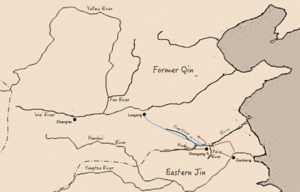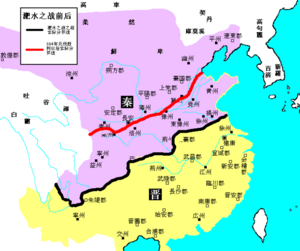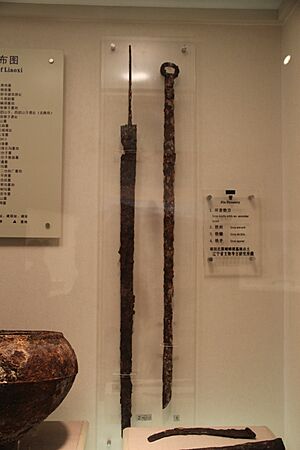Battle of Fei River facts for kids
Quick facts for kids Battle of Fei River |
|||||||||
|---|---|---|---|---|---|---|---|---|---|
 The situation during Battle of Fei River |
|||||||||
|
|||||||||
| Belligerents | |||||||||
| Former Qin dynasty | Eastern Jin dynasty | ||||||||
| Commanders and leaders | |||||||||
| Fu Jiān (Emperor Xuanzhao of Former Qin) Fu Rong † Yao Chang Murong Wei Murong De Murong Bao |
Xie An Xie Xuan Xie Shi (謝石) Xie Yan (謝琰) Huan Chong Huan Yi |
||||||||
| Strength | |||||||||
| Book of Jin records 870,000 | 80,000 elite Beifu troops | ||||||||
| Casualties and losses | |||||||||
| Book of Jin records 700,000+ | minimal | ||||||||
The Battle of Fei River, also known as the Battle of Feishui, was a huge battle that happened in China in the autumn of 383 AD. In this battle, the large army of the Former Qin dynasty was clearly beaten by the smaller army of the Eastern Jin dynasty.
The Fei River, where the battle took place, doesn't exist anymore. Experts believe it was near modern Lu'an in Anhui province, close to the Huai River. This battle is seen as one of the most important battles in Chinese history. It helped the Eastern Jin dynasty and Chinese rule in the south survive. After the battle, the Former Qin dynasty fell into a big civil war and eventually collapsed. This made sure that Chinese rule continued south of the Yangtze River.
Why the Battle Happened
The Former Qin state, led by people from the Di tribe, grew very powerful in the 350s. Fu Jiān, a strong and ambitious leader, became their ruler. In 370, he conquered the state of Former Yan. By 373, he took over areas like modern Sichuan and Chongqing from the Jin dynasty. In 379, the important city of Xiangyang also fell to Qin. By 381, Fu Jiān had taken control of all of northern China and was getting ready to invade the south.
In May 383, a Jin army of 100,000 soldiers tried to get Xiangyang back. But a Qin army of 50,000 men drove them away. Because of this, Fu Jiān ordered a massive call-up for war against Jin. Six out of every ten healthy men were forced to join the army. He also gathered 30,000 special guards.
In August 383, Fu Jiān sent his brother, Fu Rong, with an army of 300,000 as the first group. Fu Rong had actually disagreed with the plan to invade. Later that month, Fu Jiān himself marched from Chang'an with 270,000 cavalry (soldiers on horseback) and 600,000 infantry (soldiers on foot). In September, Fu Jiān reached Xiangcheng. Other Qin armies were also moving from Sichuan. The main attack was planned for the city of Shouchun on the Huai River.
Emperor Xiaowu of Jin quickly prepared for defense. He put Huan Chong in charge of defending the middle Yangtze River. The defense of the Huai River was given to Xie Shi and Xie Xuan. They led the elite 80,000-strong Beifu Army. The Prime Minister, Xie An, was in charge of the overall war plan.
Huan Chong was very worried. He sent 3,000 elite soldiers to help the capital city. But Xie An stopped them, saying the court had enough soldiers. Huan Chong felt that Xie An was too confident and sending young, inexperienced leaders like Xie Xuan to fight. He worried that the country would fall to the "barbarians" (the Qin forces). However, when the Jin army won, Huan Chong was ashamed and later died from illness.
Former Qin Army
Fu Jiān's army was made up of many smaller armies. These soldiers came from the northern lands that Qin had conquered. There were also cavalry soldiers from nomadic groups like the Xianbei and Xiongnu. Most of these soldiers were not very loyal to Former Qin. Many were forced to join or joined only for food and pay. Many groups of soldiers had trouble following orders. Fu Jiān was warned that his army was not well-trained and was made up of many different groups. But he believed that his army's huge size was enough. He famously said, "My army is so huge that if all the men throw their whips into the Yangtze, its flow will be stopped."
Jin Army
Xie Xuan's Beifu army was different. It was made up of soldiers from powerful local families. These families had their own soldiers who had been trained for a long time. This army was very well-trained and was considered a professional fighting force.
The Battle
In October 383, the Former Qin forces led by Fu Rong captured the important Jin city of Shouyang. Fu Jiān saw a chance for a quick victory. He left his main army at Xiangcheng and rode with 8,000 light cavalry to meet Fu Rong.
Fu Jiān sent a Jin official named Zhu Xu, whom he had captured, to try and convince Xie Shi to surrender. But Zhu Xu secretly told Xie Shi that the entire Former Qin army had not yet arrived. He advised Xie Shi to attack the first Qin forces to weaken their campaign. Following Zhu Xu's advice, Xie Xuan and Liu Laozhi led 5,000 elite Jin soldiers to attack the first Qin forces. They won a huge victory, killing 15,000 Qin men. After this, Jin troops spread out widely to make it look like they had as many soldiers as Former Qin. Because of these early small defeats and the Jin's spread-out formation, Fu Jiān thought the Jin had many more soldiers than they actually did.
In November 383, the Former Qin troops set up camp west of the Fei River. The Jin forces stopped east of the Fei River and could not move forward. Xie Xuan sent a message to Fu Rong. He suggested that the Former Qin forces move back a little to the west. This would let the Jin troops cross the Fei River so the two armies could fight properly. Most Former Qin generals did not like this idea. They knew that moving such a huge army was too difficult, especially with so many poorly trained soldiers. However, Fu Jiān ignored them. He planned to attack the Jin army as it was crossing the river, hoping to catch them off guard and split their forces. Fu Rong agreed and ordered his army to retreat.
The Jin's clever plans and secret messages now paid off. Many soldiers in the Former Qin army wondered why they were suddenly ordered to retreat. As they were already moving back and feeling discouraged, the Former Qin army panicked. Zhu Xu, the captured official, shouted, "The Qin army has been defeated!" This caused total chaos. The army was routed, meaning they ran away in disorder.
Xie Xuan and generals Xie Yan and Huan Yi quickly crossed the river and launched a major attack. The rumor, "Qin is Defeated," spread very fast, and more chaos followed. Fu Rong tried to stop the retreat and get his soldiers back in order. But his horse suddenly fell, and he was killed by the advancing Jin troops.
The Jin generals saw the messy footprints and wheel marks. They realized that the Former Qin army was not just retreating in an organized way; it was completely falling apart. The Jin soldiers kept chasing them, and the entire Former Qin force collapsed.
A huge amount of food and supplies were left behind as Former Qin soldiers tried to escape. During the retreat and chase, it's believed that 70-80% of the Former Qin soldiers died. They died from fighting, starvation, and being exposed to the cold.
What Happened Next
The Jin army defeated the much larger Former Qin forces with only a few losses. The Jin had chased and killed most of the escaping Former Qin soldiers. This greatly weakened the Former Qin's ability to gather more troops. Fu Jiān's forces could not be put back together, even after he finally reached Luoyang. He was protected by Murong Chui and his 30,000-man army, which was one of the few that did not fall apart.
After the news of the defeat at Fei River spread, local uprisings began. Murong Chui used this chance to ask Fu Jiān to let him lead an army to stop these rebels in the eastern part of the empire. But instead, Murong Chui himself rebelled in early 384. This started a chain reaction of many Xianbei and Qiang uprisings. The Former Qin capital, Chang'an, fell in 385 to the Xianbei forces of Western Yan. Fu Jiān himself was killed later that year by his former general Yao Chang, who founded the Later Qin dynasty. While Former Qin lasted until 394, it never became powerful again.
After the battle, Jin forces moved north to the Yellow River. They took back much of the central Chinese lands. This set the stage for Liu Yu's expeditions and the period of the Southern and Northern dynasties that came soon after.
This battle is famous not only because it was so important in history but also because it showed how vital troop training, morale (how confident and happy soldiers are), loyalty, and good leadership are in a battle. The battle was also important because it made sure that South China would stay independent until 589 AD. At that time, North China was again ruled by a Chinese dynasty, the Sui dynasty.



